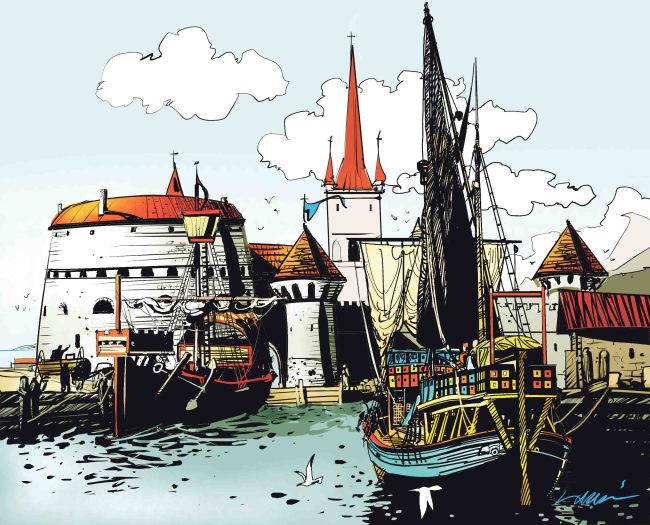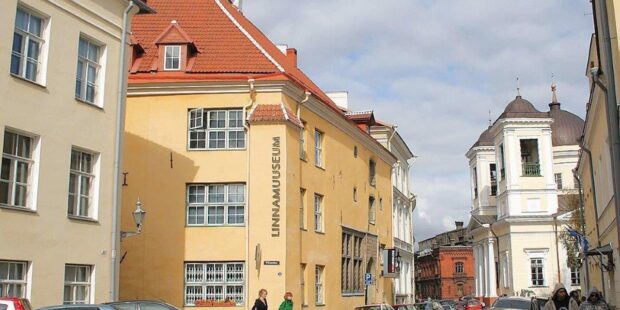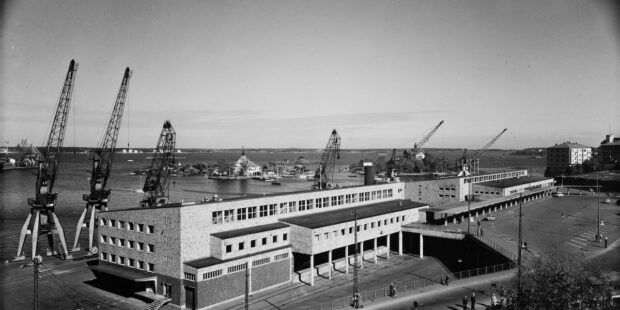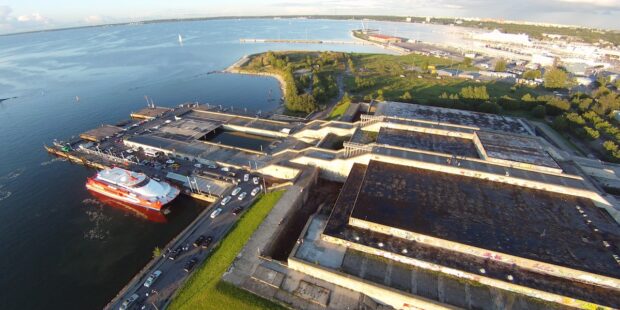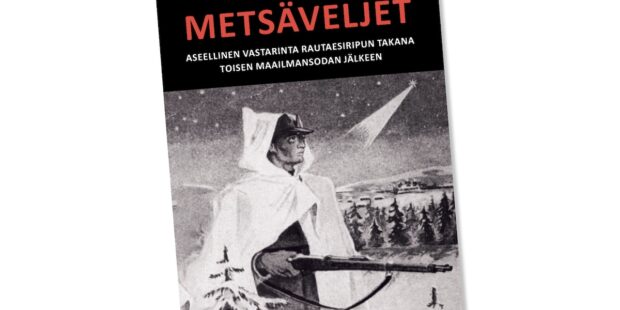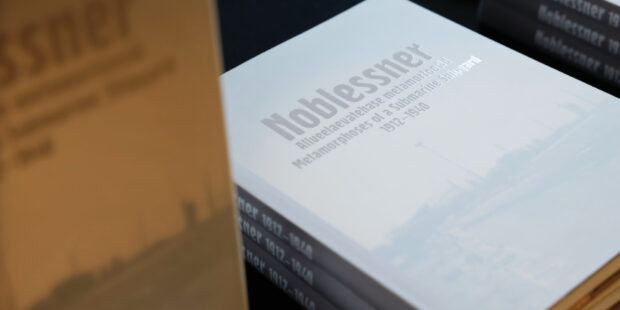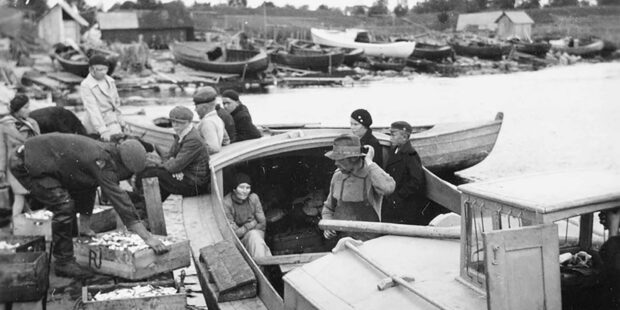In the Middle Ages, Tallinn was a Hanseatic League city where German was the primary language
Text Antti Sarasmo Illustration archive of The Baltic Guide/Hannu Lukkarinen
There were merchant houses along the main street. In Hanseatic League cities such as Tallinn, they were built end to end on the side of the street, with the actual house hidden away in the courtyards.
The first floor was the living floor, with the other floors serving as storage space. The goods were lifted into and out of the higher floors with a gable winch. In later centuries, the upper floors were also used for residential purposes, but even the big merchants lived in quite cramped conditions in medieval Reval (the name of Tallinn at the time).
At the end was the official front door of the house and behind it the “shop”. The merchants with the largest houses primarily traded in grain and salt. The grain from Estonian manors being exported from Estonia and salt imported.
The nobility got their money from grain, so the merchants made sure that they had suitable goods available for the wealthy nobles. There were fine fabrics from Flanders, magnificent weapons and armour from Frankfurt and Nuremberg, there were southern delicacies such as wine, as well as almonds and spices obtained from Arab traders via the Venetians.
Spices were expensive, even pepper. Ordinary people had no interest in this kind of trade.
There were country merchants for the common non-noble. They sold goods that could not be bought from the city’s artisans and also bought imported goods from large merchants. Country merchants lived much more modestly, but it was still possible for a German craftsman to visit their shops.
Estonian merchant’s shops were often in the basement with only a small shop at street level. The covered terrace pavilion of one of the restaurants in town hall square today is built to look like a medieval shopkeeper’s street-level shop.
In the town hall square’s market, country people sold food to city people in the morning, food was actually bought to the market every day. The town’s artisans made clothes, shoes and, for example, carriages for the townspeople. There were different levels of people. The same master did not make a bun for a nobleman and a workman belonging to the peasantry.
The city had no significant industry at the time, but its income came from forwarding goods.
Merchants kingdom
Reval was a city republic, meaning it decided its own affairs. In the Republic of Reval in the Middle Ages, the big merchants had the power.
The large merchants belonged to a guild, or the Great Guild, it was from the latter that members of the city council were elected, which was the parliament of the city republic. A couple of mayors were elected from the council, who were the presidents of the city republic.
Ordinary townspeople were not asked anything. The Great Guild had less than a hundred Hanseatic merchants engaged in foreign trade as members, and about 4,500 people lived in the town. So there was no question of a democracy of free citizens in the model. However, the townspeople were all free citizens.
Serfdom prevailed in the Baltics. Farm workers were part of the manor’s possessions, for example, being sold along with the property. A serf lived in the village and “rented” his small farm from the manor and the rent was paid as work for the manor. Somehow it just happened that in all the countries that used serfdom and in all their manors, the serf had “rent” in arrears, so he could not move out of his farm but had to do the work for the manor. Of course, you could run away.
If a serf made it to a city, such as Tallinn, then he was almost safe. If an escaped serf could support himself on his own with work in the city for a year and one day, he received the “citizenship” of the city and was freed from the obligations of a serf. It was said that “city air makes you free”.
Of course, the nobility didn’t like this, but after all, there were not mass escapes, and the escape of individual people, manors could handle. It was also not worth arguing with the city about what it would have sold the grain for, if the merchants of the city had not agreed to buy it.
The Hanseatic world
The Hanseatic League was the most significant influence in the Baltic Sea region in the Middle Ages. It was a “traders association” that pursued the common interests of its members. The basic unit of the Hanseatic League was a Hanseatic city, and at that time the merchants of that city’s Great Guild were members of the Hanseatic League, and they had trading rights in all cities belonging to the alliance.
A Hanseatic merchant from Tallinn could work for a few years, for example in Hamburg, try his luck in the North Sea trade in Bremen and return back to Tallinn.
The sons of merchants were usually sent to a business acquaintance to learn the merchant’s trade, and preferably to another Hanseatic city. From Lüpek you could come to Tallinn, from there you could go to Riga, you could find a merchant’s daughter from Visby as a wife, and if, for example, the older brother got a trading house in Lübeck, then you could set up your own trading house in the already familiar Tallinn.
Ships sailed along and across the Baltic Sea carrying cargo and passengers. In the Middle Ages, Reval was a very “international” city, people travelled to and from here, news spread and fashion products went on sale at approximately the same time as in the cities of Northern Germany.
Really, Reval was not an international city, because its reference group was the Hanseatic world and in all the Hanseatic cities people lived according to the same customs, spoke the same German language and maintained the same values. It really didn’t matter to the German population of the Hanseatic city what language the service people, or country people, spoke and what customs they had. There were two worlds, the world of the local people and the world of the Hanseatic League.
German Reval and Estonian Tallinn
There were two layers of people, or even better, two languages. In Tallinn, cultures met as they passed each other on the city streets. The Estonian language was heard in the suburbs, outside the city walls, i.e. where people other than house servants lived.
Fishermen, boatmen and other mobile professions were in the hands of Estonians. As independent practitioners of their profession, they offered work services for purchase, such as taking a wagon load to, for example, Viljandi. They did not offer a service that required presence, which was an essential part of, for example, the work of an interior designer.
Inside the walls of Reval was German, the suburbs outside the walls were Estonian. Several centuries passed before Reval truly became Tallinn. Even the first Estonian mayor, Voldemar Lender, was not elected until 1906.
Indrek Hargla’s detective novels set in medieval Tallinn are very accurate at describing the city and giving a good picture of how medieval Tallinners lived.
Jaan Kross’s work, Between Three Plagues, takes place in Tallinn at the end of the Middle Ages, within it you can almost hear the footstep on the cobbled streets…
To learn more about this and similar topicsEstonian Language Hanseatic League History History of Tallinn Medieval Tallinn Middle Ages Reval Tallinn

